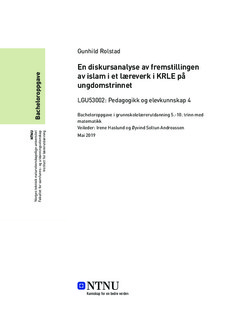| dc.contributor.advisor | Haslund, Irene | |
| dc.contributor.advisor | Andreassen, Øyvind Soltun | |
| dc.contributor.author | Rolstad, Gunhild | |
| dc.date.accessioned | 2019-08-23T14:07:39Z | |
| dc.date.available | 2019-08-23T14:07:39Z | |
| dc.date.issued | 2019 | |
| dc.identifier.uri | http://hdl.handle.net/11250/2610299 | |
| dc.description.abstract | Språket spiller en sentral rolle for kunnskap om og syn på verden, og er både produsent og bærer av ideologier, verdensbilder, makt, verdier og kunnskap (Grue, 2011; Skrede, 2017). I mediebildet har «religion» blitt en utbredt identitetsmarkør, og for å kunne se forbi de ladede stereotypifiseringer, generaliseringer og forenklinger som finnes i populærkulturen, kreves en bakenforliggende kunnskapsbase (Døving & Kraft, 2013, Grillo, 2010 i Døving & Kraft, 2013). Med bakgrunn i skolens rolle som utdanningsinstitusjon, har jeg i dette prosjektet undersøkt hvilket bilde som tegnes av islam i et tekstgrunnlag som fungerer som kunnskapskilde i norske klasserom. Målet er å få en forståelse av hvordan islam fremstilles i et læreverk på ungdomstrinnet. Det aktuelle tekstgrunnlaget har blitt analysert og diskutert ved hjelp av Norman Faircloughs tilnærming til kritisk diskursanalyse og sentrale perspektiver hentet fra postkolonial teori, Edward Saids orientalismekritikk og religionsdidaktikkens evinnelige univers. Faircloughs modell innebærer en analyse av lærebokteksten i tre ulike nivåer: 1) som sosial begivenhet, 2) som sosial praksis og 3) som sosial struktur, og har bidratt med å avdekke de ideologier og verdensbilder som lever i lærebokteksten – og mer konkret hvordan KRLE-boka 8-10 tidvis har latt seg fargelegge av orientalisme og kolonial tenkning. I tråd med en postkolonial forståelse har analysen synliggjort en tydelig selektiv og forenklet fremstilling av islam; tidvis som en homogen gruppe og en ideell islamsk livsførsel, og tidvis forankret i egen kultur gjennom paralleller til særkristne begreper. Heller enn å anerkjennes og tilføres nyanserende perspektiver, kunnskap og forståelse, behandles mer kontroversielle temaer som omskjæringsritualet, det likekjønnede ekteskapsforbudet, hijab og sharia overfladisk eller ikke overhodet. Samtidig legitimeres andre religionsspesifikke begreper og konsepter gjennom intertekstuelle referanser til Koranen og hadith, som bidrar både til å underbygge og ivareta et islamsk særpreg og til å motbevise medienes forestillinger om muslimen som ekstremist, kvinnen som undertrykket og imamen som uoverstyrbar religiøs autoritet (Endsjø & Lied, 2011; Døving & Kraft, 2013). | |
| dc.description.abstract | Language is an essential part of both our knowledge and thoughts of the world, and therefore operates as both a producer and a distributor of ideologies, world views, power, merits and knowledge (Grue, 2011; Skrede, 2017). As “religion” has become a widely used identity mark in the media, the need for a solid base of knowledge has increased additionally (Døving & Kraft, 2013; Grillo, 2010 in Døving & Kraft, 2013). According to the understanding of schools as educational institutions, this project is trying to look into how Islam is portrayed in a textual fragment operating as a source to insight and understanding in Norwegian classrooms. The intention is to get an understanding of how Islam is depicted in a lower secondary school-textbook. The prevailing textual source has been analyzed and discussed by Norman Fairclough’s approach to critical discourse analysis and other connected perspectives from postcolonial theory, Edward Said’s critique of the oriental studies and didactics of religion. Fairclough’s model entails an analysis of the textbook chapter in three different levels: 1) as a social event, 2) as a social practice and 3) as a social structure, and thereby contributed to uncover the ideologies and world views existing within the textbook – and more precisely how KRLE-boka 8-10 sporadically has been influenced by orientalism and postcolonial thinking. Consistent with a postcolonial understanding, the analysis has revealed a distinct selective and simplistic portrayal of Islam; occasionally as a homogenic group and the ideal way of living an Islamic life, and occasionally anchored in their own culture through parallels to specific Christian concepts. Rather than acknowledging and supply diversifying perspectives, knowledge and understanding to the more controversial matters such as the ritual of circumcision, the prohibition of same-sex marriage, hijab and sharia, the textbook addresses them either superficially or not at all. On the other hand, other Islam-specific concepts and matters is legitimized through intertextual references to the Qur’an and hadith, and therefore contributes both to substantiate and preserve the Islamic peculiarities and to disprove medias representations of Muslims as extremists, Muslim women as subjugated and the imam as an insuperable religious authority (Endsjø & Lied, 2011; Døving & Kraft, 2013). | |
| dc.language | nob | |
| dc.publisher | NTNU | |
| dc.title | En diskursanalyse av fremstillingen av islam i et læreverk i KRLE på ungdomstrinnet | |
| dc.type | Bachelor thesis | |
